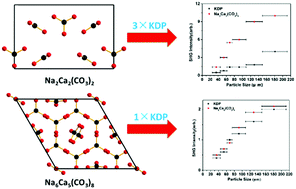Explorations of new UV nonlinear optical materials in the Na2CO3–CaCO3 system†
Abstract
Three UV-transparent orthocarbonates, namely, the acentric Na6Ca5(CO3)8 (P63mc) and Na2Ca2(CO3)3 (Amm2) and the centric Na2Ca(CO3)2 (Pbca), have been successfully synthesized by hydrothermal method and high-temperature solid-state method. The structure of Na2Ca2(CO3)3 consists of an alternate stacking of the [Na(CO3)2]∞ and [NaCa2CO3]∞ layers. The structures of Na2Ca(CO3)2 and Na6Ca5(CO3)8 all present 2D [CaCO3]∞ layers, which are bridged via [CO3] groups to construct a 3D framework. The Na and [Na0.67Ca0.33] atoms reside in the cavities of the 3D network. Thermal analysis of all compounds was performed. In addition, the results of UV-vis diffuse reflectance spectroscopy indicated that the three compounds all have wide transparent regions, among which the UV cutoff edge of Na6Ca5(CO3)8 is shorter than 200 nm, and the UV cutoff edges of Na2Ca2(CO3)3 and Na2Ca(CO3)2 are about 205 nm and 247 nm, respectively. More importantly, the powder Na6Ca5(CO3)8 and Na2Ca2(CO3)3 samples exhibited moderate second harmonic generation (SHG) responses of 1 and 3 times that of reference KH2PO4 (KDP). Besides, for all compounds, their electronic structures and optical properties were analyzed by using density functional theory (DFT) calculation.



 Please wait while we load your content...
Please wait while we load your content...